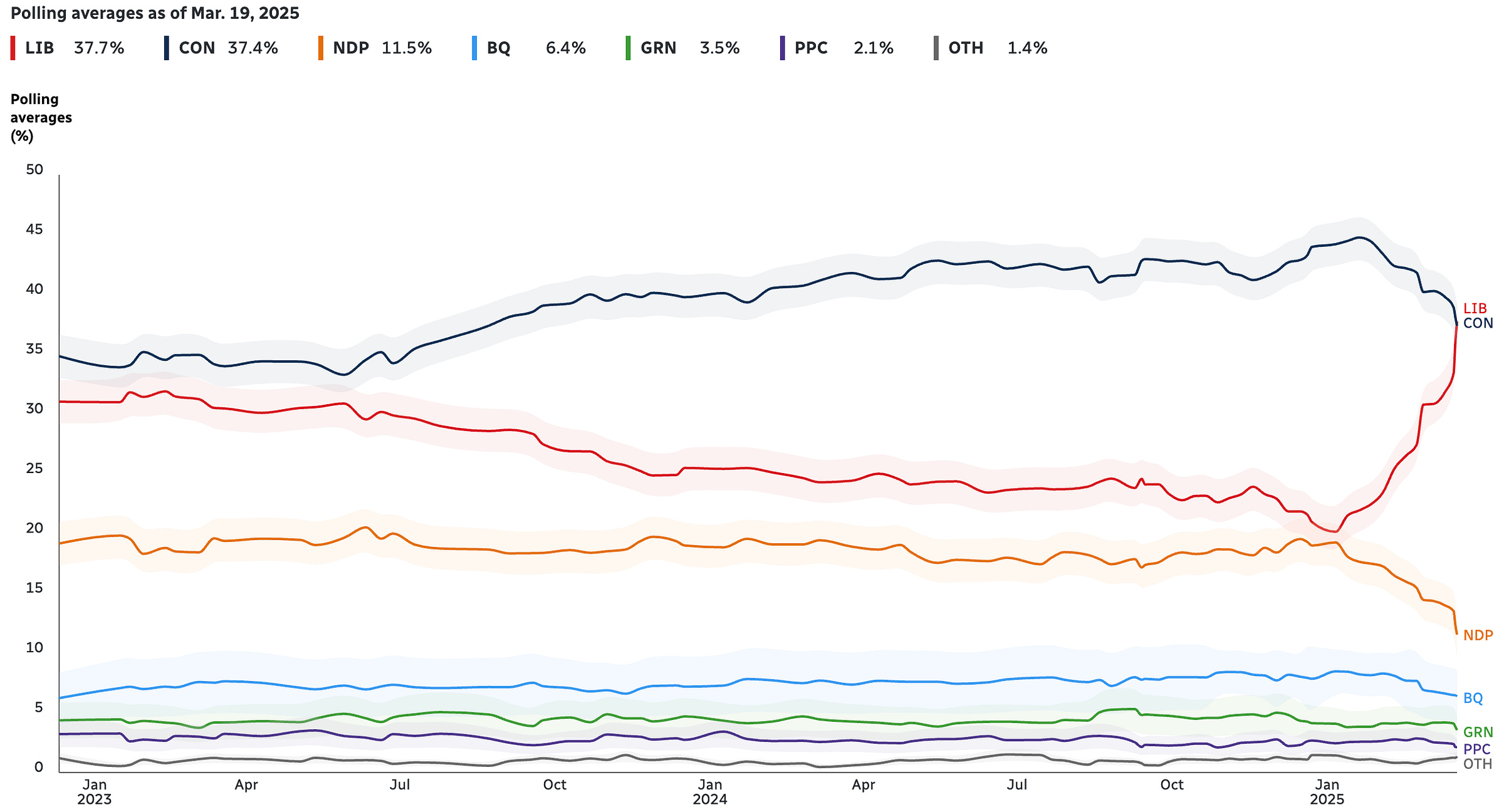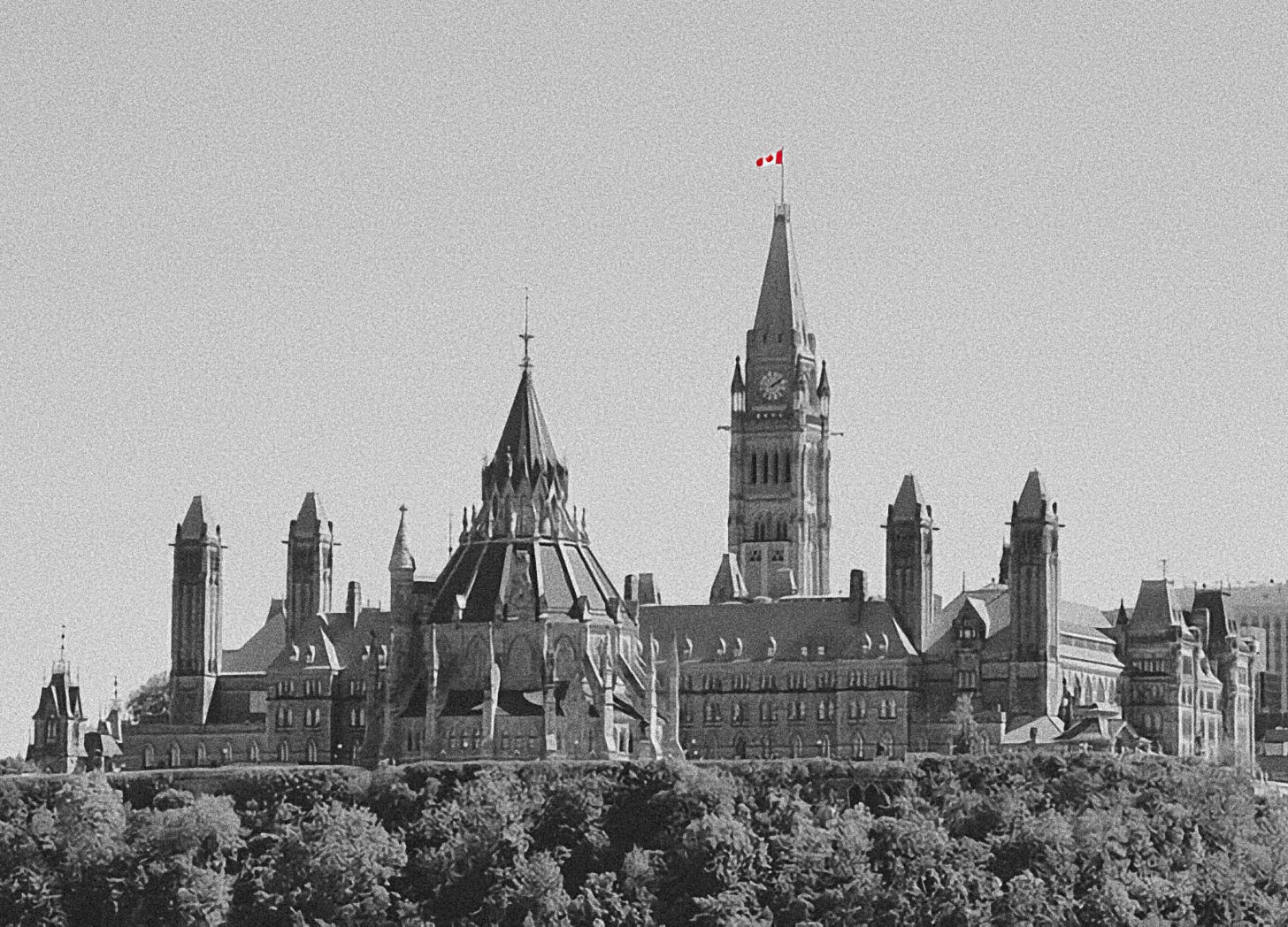The Threshold of an Unrecognizable Campaign
by Julian A.S. — How a long-anticipated election was turned on its head.
by Julian A.S.
Mark Carney has been our prime minister for just seven days. This weekend, he is expected to ask the Governor General to dissolve Parliament, and a federal election will officially—finally—be underway. Back in the fall, most analysts and pollsters were projecting a Liberal implosion, and put the odds of a Conservative majority at almost 100%. Today, the election looks a lot like a toss-up. At the conclusion of this campaign, Pierre Poilievre may well be our new prime minister, but a Conservative government is no longer the sure thing it once seemed to be. In any event, I want to reflect briefly on how remarkable it is that this long-anticipated election ever became so uncertain.
For much of last year, the Conservative Party with Pierre Poilievre at the helm enjoyed a dominating lead, fluctuating around 20 points ahead of the Liberals in national polling. There was a general sense that people were souring after a decade of the Trudeau Liberal’s management of major issues like the cost of living crisis, the housing crisis, and immigration—all compounded by global post-pandemic inflationary trends. It seemed clear that the Conservatives were coasting into a landslide victory. I was certainly expecting as much.
Then, Donald Trump won re-election in the US. Immediately, everything began to change. Soon after the presidential election, Trump began indicating that Canada was in the crosshairs in ways that almost no one had anticipated. The juggernaut of sweeping 25% tariffs on all US imports from Canada is a catastrophic threat to the economy—with the potential to hurt American businesses and consumers, and throw Canada into a recession—which flies in the face of enduring free trade agreements. Why would the US do this? The initial justification was purported concerns over border security.
According to US Customs and Border Protection, the amount of fentanyl entering the US from Canada accounted for less than 0.2% of all US fentanyl seizures last year. And at least a third of that tiny fraction was misattributed to Canada in the first place. Clearly, Trump’s early pretext for his contempt did not hold up to even basic scrutiny. Nonetheless, an alarmed Trudeau government began trying to appease Trump by taking him at his word and seeking to beef up border enforcement.
Then, Trump began complaining that Canada is taking advantage of the United States by (what’s this?) adhering to the very CUSMA trade agreement that Trump himself negotiated and signed. Right. Then it was banking. Then it was the digital services tax. Then it was the border again. On and on it goes. Trump’s constantly-shifting goalposts and bombastic grievances became paired with repeated, profoundly insulting “51st state” comments on Canadian sovereignty. Even when some attempted to dismiss these taunts as a joke, nobody was laughing. It became increasingly clear that Trump’s tariffs and other threats are a solution in search of a problem. One way or another, factions in the US government are seeking to destabilize Canada to uncertain ends, which has left Canadians with a prevailing sense of unease and betrayal.
The once close-knit relationship between the United States and Canada has deteriorated rapidly, unexpectedly, and perhaps irrevocably. In the late autumn, as Canada’s largest economic and foreign policy crisis in years began to unfold, Canadians looked to our top national officials for leadership. We were faced with a lame duck prime minister who was nearing the end of his political rope, and risked losing the support of not just an antsy electorate but of his own government.
Under mounting pressure, Justin Trudeau announced his resignation in early January, effective upon the selection of a new Liberal Party leader. Suddenly, the Trudeau-Poilievre face-off we had been expecting for several years evaporated.
Meanwhile, the crisis continued to deepen. In early February, on the brink of Trump’s first tariff deadline, the outgoing prime minister delivered a decisive, reasonable, and impassioned speech at a crucial moment. He exalted the decades-long Canada-US partnership, highlighted economic interdependence, and promised a regrettable but forceful response. These soaring political speeches are, undeniably, Justin Trudeau at his best, what I like to call debate club Trudeau. In moments like these, the Liberal government’s ardent stand against a common national threat has allowed them to score political points even with voters who have otherwise grown weary of them. This “rally around the flag” boost to incumbents is a recognized political phenomenon in times of emergency.
Simultaneously, and more extraordinarily, Trudeau’s resignation appears to have softened the brunt of recent global anti-incumbent sentiment in the Canadian context—not to mention the Canada-specific anti-Trudeau vitriol. The Conservatives have spent years trying to paint their policy grievances as personal failings of Justin Trudeau. As a result, it seems that Trudeau’s resignation has granted the Liberals at least some distance from their record. This was soon accelerated by the fact that Mark Carney quickly became the heir apparent. His status as a relative political outsider with serious economic expertise has made him a compelling candidate at this precarious moment.
In short, the crisis may have offered the Liberals a rare chance to reap the benefits of holding government while also, inversely, shedding some of the electoral peril of a long-held and increasingly unpopular incumbency. Carney understands this, and is playing into it: his first move as PM was to end the controversial consumer carbon tax, which immediately sullied Polievre’s favourite wedge issue.

None of this bodes well for the Conservative Party. Poilievre’s struggle to adapt to recent developments has been brutal, and his party’s once-untouchable lead in the polls has vanished. As Canadians look to a new government for a unifying vision in uncertain times, it seems that Poilievre’s trademark brand of bitter snark, division, and penchant for snappy—sometimes Trumpian—slogans has not met the moment well. Poilievre has continued with the same tired and cynical lines of attack: Mark Carney is a “sneaky” liar and “just like Justin”; NDP leader Jagmeet Singh earning a government pension remains an outrage (never mind that career-politician Poilievre is sitting on a pension 300% that of Singh’s, courtesy of the Canadian taxpayer).
The Poilievre Conservatives' erstwhile platform of (explicitly) AX THE TAX and (implicitly) F*CK TRUDEAU has not adjusted well to a transformed campaign against a new Liberal antagonist, new policy positions, and an unprecedented American threat. Insofar as the Conservatives have haltingly attempted to pair their previous rhetoric with a more unifying and conciliatory CANADA FIRST approach, their messaging has become dissonant and confused. It seems that years of deriding Canadian society, institutions, and leaders for political gain is a difficult position to reconcile with many Canadians now reporting surging national pride. (même les québécois! tabarnak!)
It also hasn’t helped that Poilievre is the clear MAGA favourite. Elon Musk, the unelected, unaccountable, and extraordinarily unpopular oligarch currently sabotaging the US government, voiced his support for Poilievre, which Poilievre declined to meaningfully distance himself from. Trump himself has recently made some half-hearted attempts to shun Poilievre by calling him “stupidly no friend of mine” and not enough of a MAGA guy, comments which strike me more as a demand to bend the knee than a meaningful rift. The Liberals have been hammering this angle.
With the unifying foil of Trudeau suddenly replaced by Trump, Poilievre finds himself on a high wire, trying to balance mutually exclusive expectations from disparate factions of his big tent party: the wealthy suburban retiree in the GTA who supports Doug Ford but despises Trump no longer shares a common enemy with the 20-something Calgary oil industry insider whose feelings of western alienation have left them hungry for a Canadian MAGA analog. Over the course of the coming weeks, Poilievre must seek a delicate equilibrium: play to the right flank without alienating moderates; reassure the centre without losing the hardliners.
Recent polling reveals how rapidly these new dynamics have shifted national public opinion. The election feels increasingly like a referendum on which major party leader is best suited to successfully handle the Trump administration. Much of the renewed enthusiasm for the Liberals seems to be coming primarily at the expense of the NDP, perhaps due to left-leaning Canadians’ intuitive understanding of the strategic vote: those freshly concerned by Poilievre and Trump seem increasingly willing to abandon their first choice NDP or Bloc candidate in favour of the Liberals in order to hurt the chances of the Conservatives. However, this variable is still very apt to change as the race now officially unfolds.
So far, Poilievre has struggled in both substance and style to recalibrate his politics of division. Whether the Conservatives can find their rhythm as the campaign now begins in earnest remains to be seen. At the same time, the geopolitical earthquake of Trump 2.0 might have been just enough to jolt the stagnant Liberals into finally offering a (somewhat) reinvigorated vision for the country. That doesn’t mean that they are home free: the Liberals remain vulnerable on long-standing ballot issues like the housing crisis; Carney has inherited a lengthy and controversial record; and he is untested in electoral politics.
As the campaign unfolds over the following weeks, I will be paying close attention to four broad variables. First, the unpredictable actions of the Trump administration will continue to shape the conversation and response on this side of the border. Second, the ability of Poilievre and his Conservatives to settle on a more widely palatable platform without alienating their base. Third, the extent to which Mark Carney is able to successfully leverage his short trial period as PM to shake up the Liberal reputation and convince Canadians to come back for more. And finally, if the smaller parties—specifically the NDP and Bloc Québecois—manage to find their footing in this uncharted electoral landscape.
Under threat from Trump’s America, it seems Canadians perceive an urgent need for a clear-eyed defender of Canada’s aspirations, values, and role in a changing world. Soon, we will settle the question of what that leadership will look like, though the contours of this campaign would have been unrecognizable just six long months ago.
I encourage all Canadians to visit Elections Canada’s Online Voter Registration Service to verify that you're registered to vote, update your address, or register to vote if you haven’t already!





“lame duck” PM- surely that’s not Your personal opinion! wished we lived closer for dinner table discussions. well executed piece JAS